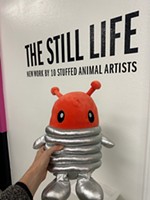The Heart of a Printer, the Art of a Chef
Designer Jeff Scott brings the culinary life to vivid, multilayered display
By Wayne Alan Brenner, Fri., April 20, 2012
"I think that art is about evoking emotion," says Jeff Scott, creator of the new two-volume book Notes From a Kitchen, which almost exhaustively documents the work and lives of some of the best chefs in this country. "Art is about provoking people and getting them to ask questions," he says. "It's about revealing things by not revealing things, by putting layers of things together, like the layers of an onion, so you have to peel away and peel away, so it reveals itself slowly over time and maybe it never reveals itself the same way again."
Notes From a Kitchen features this sort of layered-in-print treatment of 10 chefs: Sean Brock, Johnny Iuzzini, George Mendes, Emma Hearst, Michael Laiskonis, Jason Neroni, Zak Pelaccio, Joel Harrington, Matt Gaudet, and Neal Fraser. Notes From a Kitchen, either one of the two oversized and embossing-enhanced clothbound volumes, is as heavy as it is beautifully wrought. It's like trying to heft a haunch of beef, and the relentless panoply of photographs inside – kitchen scenes, tableaux of food prep and farm origins and the details of distillery and design, the storms of staging, the minutiae of quotidian life – interspersed with translucent sheets bearing images of pages and pages from the chefs' daily notebooks, well, the cumulative effect is enough to tip a cow.
But tippage like that, we dare say, is the best thing that could happen to any cow – or to your sense of aesthetics. Make no mistake: This book's a masterpiece. A certifiable masterpiece, even: It's been nominated for a James Beard award.
This is unsurprising, given not only the graphic and biographical power of Notes From a Kitchen but also the impact of Scott's previous highly visual stunner, 2005's Elvis: The Personal Archives. He's plied his creative trade and fed his artistic obsessions for a while now, and Scott, who's been coming to Austin for years for business and pleasure, now lives here – and is continuing his obsessive culinary documentation in this river city. But now, ah, he's about to shift from strictly paper volumes to filmic, motion-picture treatments of the culinary world.
We sat down with him recently to talk about what's up with all this relentless industry of his. For a look at the book from the cook's side, see "Notes From a Kitchen."
Austin Chronicle: So, from Elvis to amazing chefs. We're all aware of the Elvis and food connections, the peanut-butter-and-banana-and-marshmallow sandwiches or whatever, but surely that didn't lead to – I mean, what was the impetus behind this huge and continuing Notes From a Kitchen project?
Jeff Scott: My idea was "How to reinvent the cookbook?" And whenever I come up with an idea of trying to look at something, I go out and see what's out there, what else has been done. And although there have been so many beautiful books made with beautiful shots of chefs cooking and food, there really hasn't been this type of emotional storytelling of what a chef's life is, why chefs choose to make the decisions that they do, and what is it that informs the chef, what do they bring to the plate that makes it unique and makes it an emotional experience for the diner? I wanted to make a book that was a cookbook in the sense that it was about cooking, it was about food, it was about information and the things that are instinctual to chefs and where those things come from before the idea of making a plate even begins.
AC: How did you go about choosing the chefs you've featured?
JS: Mostly it was just friendships that I had and that led to, well, I was friends with Emma Hearst, who introduced me to her friend George Mendes, who introduced me to Johnny Iuzzini, who introduced me to his good buddy Sean Brock. So a lot of this – and this is one of the themes in the book – is this theme of giving, of generosity. All these chefs were sharing ideas back and forth and were so giving of themselves and giving their time over to me and exposing and revealing things about their lives to me. And I don't know that anyone's tried to uncover that side of the story before. The intimacy, the conviviality between the chefs and how much friendship can inform what they do. They eat at each other's restaurants, they talk to each other and hang out with each other after hours and share stories. There's just this generosity, this giving nature of chefs that I found to be pretty cool.
AC: What is it in your artistic background that's allowed you to come up with all these vellum overlays and things, the transparencies and so on that make the book so tactile?
JS: I started working on prints and making photo-polymer gravures back in '95, maybe '96, started working at Flatbed Press. And the photogravure process is interesting because it allows you to take ideas and put them onto a piece of translucent material and transfer that material onto a printing plate, then apply ink to that plate, lay the ink on the paper, and hold that paper into place as you put another inked plate on top of that plate. And you keep everything in register so you can layer everything – words over images, words over words, images over images, and this building up of information is a very provocative way of working. So when it came time to figure out what to do with the book, I chose vellum sheets because I wanted the reader to have this physical, tactile experience that was like what I had when I held the actual notebooks. So these translucent vellum sheets laid over each other, in layers over layers over layers, you get this kind of physical jolt that you won't get with any other kind of printing. This thickening of information gives it an emotional quality that's very enticing to me as an artist.
AC: You've done all these chefs, and these are some world-class people. What about any of the equally world-class, it seems to me, chefs in Austin?
JS: I'm working, putting together a documentary feature right now, a film, which I'll be shooting in the next two or three months, and I'll be doing some Austin chefs. I'm definitely going to be featuring Ned Elliott of Foreign & Domestic. Because we know what an amazing talent he is. Ned's got that special quality of somebody who's willing to take risks, which is really attractive to me, and Foreign & Domestic is my favorite restaurant in the city. I'm very into the idea of emotion and obsession, of focusing on a chef's obsession and what that means, what it means to put 12, 14, 16, maybe 18 hours a day into your job, day after day after day – just the passion and obsession that so many people in the culinary industry have. I don't think that's been properly documented onscreen, and I feel this is an opportunity to do something on film similar to what I've done with the book. Again, a layering of information, a sort of long-form authenticity of vision focusing on the life story of what chefs bring to the field, to their craft.














